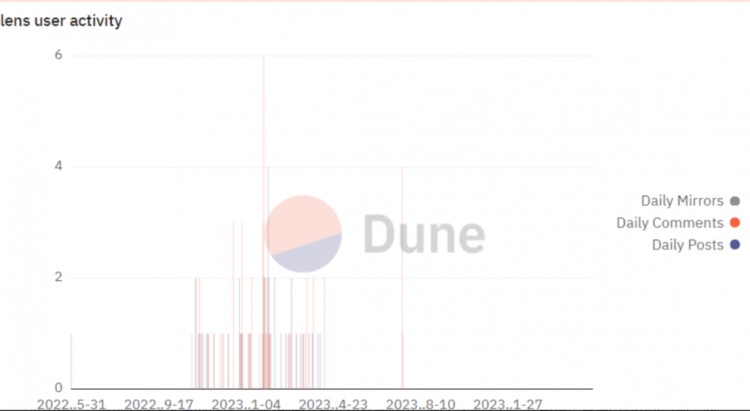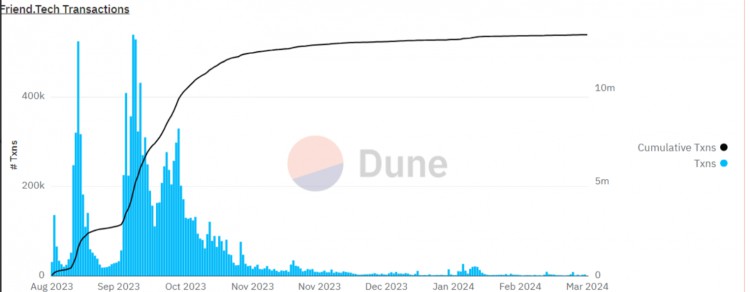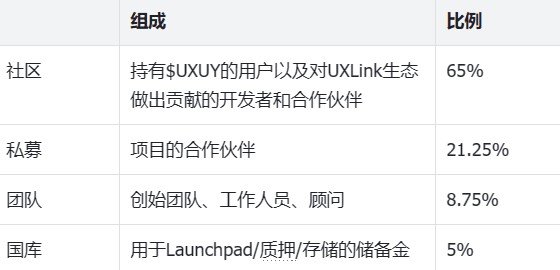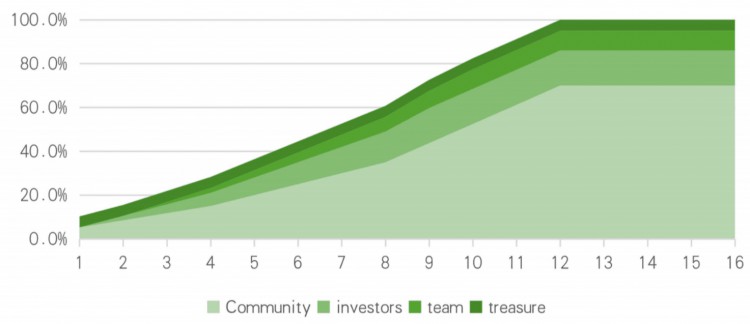The social track in Web3 has always been the most controversial track. In web3, which is all based on transaction behavior, whether on-chain social networking is a pseudo demand.
Although the first-generation social products of CyberConnect, Lens, and Farcaster were designed to improve the social infrastructure on the chain, they took a long time, cost a lot of money, and ended in failure; the second-generation product is Friend, which focuses on capitalizing social network influence. tech has achieved success with its efficient price discovery mechanism, but friend.tech has been capitalized both in success and failure. Users who bought the key at a high point have suffered huge losses. The delay in the airdrop plan and the update of the new version have caused users to Lost one after another.
If you want to say what kind of sheep the third generation will iterate in, perhaps the SocialFi product UXLink, which is centered on the off-chain acquaintance social assets of RWS (Real World Social, real world social), can give some ideas to the entire Socialfi market.
Before diving into UXLink products, let us first review the first two generations of SocialFi products represented by Lens Procotol and Friend.tech.The narrative of the first-generation SocialFi product was too grand. Lens Protocol was designed to become the basic data layer for social networking on the chain from the beginning. However, assets were not well integrated into the product. Before the SocialFi scenario was confirmed, users could not use the protocol. Strong revenue expectations were generated, and the poor attributes of "Fi" led to the loss of users.
Compared with the first generation, the second generation of Friend.tech chose a one-to-many network-like social form in the scene. The design of Bonding Curve gave early participants a large wealth effect, but at the same time, due to too much emphasis The attributes of "Fi" include a large bubble, a relatively closed system, and insufficient externalities, which leads to the rapid loss of users after the wealth effect weakens.
In the latest third generation, UXLink targeted the acquaintance social segment from the beginning of its design, and designed a dual-token model on the asset side. The design of the product architecture is more complex, divided into basic application layer, protocol service layer and infrastructure layer, which support and complement each other, and leave enough interfaces for the access of external protocols. In the social scenario of acquaintances, UXLink has realized a social ecosystem that integrates traffic portals, social asset transactions, and infrastructure. Let us dismantle UXLink's product framework from top to bottom.

The function of the application layer mainly provides basic product services such as growth fission and group functions for ecological applications. This layer utilizes MPC-TSS wallet account service and group-based EOA account service to reduce user entry barriers and protect the security of user assets. The current main products include the following three sectors:
UX Wallet & DID: MPC-based AA enhanced wallet that users can create through Telegram/WhatsApp, which can perform social recovery and custody, balancing security and low entry barriers. When creating a wallet, zk technology will be automatically used to create SBT based on real-world connections for users. Users can inherit and use their own independent identities and off-chain social relationships while protecting privacy;
UX Group: Group is the basic unit of social network in UXlink. It uses AI to manage group resources and data and empower them;
UX Social Dex: Users can directly trade crypto assets based on the AA wallet. The IDO platform and lending platform will be launched later.
In the protocol layer, UXLink retains open interfaces for ecological externalities, including services that developers can efficiently manage user social identities and relationship data through APIs and ABIs. This seamless integration ensures dynamic and composable on-chain social applications.
In the infrastructure layer, UXLink adopts a hybrid scalable architecture (EVM + IPFS + cloud), including Ethereum main network, Arbitrum L2 chain, BNB chain, Polygon and Base Chain and other EVM chains, integrating decentralized storage and The centralized data indexing service retains ecological scalability from the beginning of infrastructure construction.
Regarding the expansion of the interface, if you have some understanding of the Web2 marketing Saas platform, you will know the ambition of UXLink and the ingenuity of its layout - compared with the number of users, the value of user data is equally important. With the application intervention of external interfaces, the measurement of user value is no longer limited to the single dimension of a single application. Each application scenario is a new value dimension.
The so-called externality is the key to breaking the social death spiral.
SocialFi=Social+Fi. Any web3 product cannot do without assets. The first two generations of SocialFi products did not have a balanced grasp of "Fi", which led to two extreme situations. The first generation of SocialFi product Lens focused too much on the infrastructure layer, and the asset side turned all social behaviors into NFTs, which limited the profit space for users. In addition, the airdrop expectations were not fulfilled for a long time, and users' limited funds and attention flowed to other products with higher profit expectations, resulting in terrible product usage data.

The second-generation SocialFi product, Friend.tech, was too radical in its "Fi" design. Although the Bonding Curve design attracted a large amount of funds and users in a short period of time, it also formed a large number of bubbles. Due to profit withdrawal and transaction attrition, long-term users generally suffered ETH-based losses. Also, as the airdrop expectations did not materialize for a long time, most users chose to stop their losses and leave.

Referring to the experience of the first two generations of flagship products, UXLink adopts a more balanced dual-token model on the asset side, decoupling governance and utility and dividing it into two tokens: $UXUY and $UXLink.
$UXUY is an incentive token used for community and ecological development. The sooner users create a social network to contribute to the ecosystem, the more $UXUY they receive. This approach ensures equitable and incentivized growth for the community.
$UXUY uses a decreasing logic similar to Bitcoin in terms of quantity, and adopts a calculation formula that is closely integrated with Bitcoin mining logic. Key variables that affect token reduction include time, the number of connections to a single node, and the total number of users across the UXLink network. As time goes by and the UXLink network expands, the UXUY users receive will decrease exponentially. Therefore, users who enter the UXLink network later will receive less $UXUY, emphasizing the scarcity and value of early participation.
$UXUY can be used to pay on-chain gas fees within the entire ecosystem, covering transactions, transfers and social network interactions, and is subject to UXLink’s token destruction mechanism.
UXLink uses asset quantity rather than price to motivate users to participate early, and is more gentle in creating bubbles. Although it does not have the powerful wealth effect of Friend.tech, it can ensure the healthy and sustainable development of the entire system.
$UXLINK is mainly used for the governance of the project and to capture real income from the UXLink ecosystem and distribute it to community users. The token supply and distribution are as follows

It is worth noting that of the 65% community allocation, 40% is allocated to users, and all other ecological contributors and partners hold 25%

The release of $UXLINK is closely related to community members and ecological contributors. According to the generation formula of $UXUY, the potential supply reaches the maximum when the number of users reaches 30m. Of course, when the number of users reaches 30m, the network can operate stably without further incentives. .
In the product cycle, Web3 takes one day and Web2 takes one year. If the release of Friend.tech brought the Twitter moment of the SocialFi track, then UXLink, which started from acquaintance social networking and was more balanced in all aspects, is the third generation that started the WeChat moment. SociaFi Products.
Since the launch of the product, excellent data growth has been achieved in terms of both quality and quantity of users. In terms of quantity, it has now achieved 4.6 million total users, 80,000+ groups, and the total number of people covered by the groups has reached 6.55 million; in terms of quality, it has achieved After the web3 wallet function was launched in February this year, more than 978,000 new wallets were created and connected to UXLink in one month, with an average of more than $70 in assets held in each wallet, and the new registration/UV ratio reached an astonishing 42%.
The SocialFi product model based on off-chain real-world social networks has been verified in actual combat. With such a huge user base and complete infrastructure and application layers, we can expect the UXLink ecosystem to explode in the bull market and set off a new era. A wave of SocialFi.
